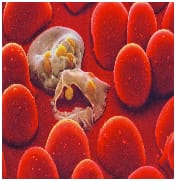National Strategic Plan (NSP) for Malaria Elimination (2017-22)
Malaria has been a major public health problem in India. At the time of independence, there were 75 million cases of malaria reported every year. To tackle the problem, government took first major step and launched the National Malaria Control Programme in 1953. Since then, the national strategy on malaria control has undergone a paradigm shift. In 2002, the malaria control programme and other vector control programme were integrated into the National Vector Borne Disease Control Programme (NVBDCP). And recently, the Union Health Ministry has come up with National Strategic Plan (NSP) for Malaria Elimination (2017-22). The plan has an estimated budget of Rs 10, 653.16 crore, and aims to mitigate the number of malaria cases in the country by 2022.
Background
Malaria is caused by the parasites Plasmodium falciparum (Pf) and Plasmodium Vivax (Pv). While Pf is more prevalent in the forest areas, Pv is predominant in the plains. Out of 9 species of malaria vectors, the major vector for rural malaria is Anopheles culicifacies, which breeds in clean ground water collections. In urban areas, malaria is mainly transmitted by Anopheles stephensi which breeds in man-made water containers. In India, the disease is mainly concentrated in the tribal and remote areas of the north-east, plains of Uttar Pradesh and Bihar, and coastal areas of south eastern India.
Brief description about the Programme
National Strategic Plan (NSP) divides the country into four categories, from 0 to 3. The first category is Zero. This consists of 75 districts which have not reported any case of malaria for the last three years. The second category is One. This consists of 448 districts which have reported Annual Parasite Incidence (API) less than 1 or annual cases less than one per 1000 population. Third category is Two. This consists of 48 districts which have reported Annual Parasite Index greater than one but less than two per 1000 population. Fourth and the last category is Three. This consists of 107 districts, reporting an API of two and above per 1,000 population. The NSP aims to eradicate malaria by 2022 in all the districts under category one and two. The remaining districts will be brought under a pre-elimination and elimination programme that is between the sustained control and elimination stages. The NSP also aims to provide 100% diagnosis facilities for suspected cases and full treatment for confirmed cases in malaria endemic districts. The plan has four components, based on WHO recommendations: diagnosis and case management; surveillance and epidemic response; prevention-integrated vector management; & ‘cross-cutting’ interventions. According to the NSP, the finances for the national plan would be managed from government sources, international donors, and the corporate sector as part of corporate social responsibility.
How the Disease is being controlled?
Nearly 50% of the total malaria cases reported in country are due to P.falciparum. The reason being P.falciparum parasite resistance to Chloroquine, the most widely used drug to treat and prevent malaria in the country. To cope up with the problem, the government has already formulated the National Drug Policy for Malaria (2013). The salient features of the policy are:
- Treatment of uncomplicated P. falciparum cases though a complete course of three days Artemisinin based Combination Therapy (ACT) along with single dose of primaquine 0.75 mg/kg body weight on day 2.
- Treatment of uncomplicated P. Vivax cases through Chloroquine with 10 mg/kg body weight on day 1 and day 2, and 5 mg/kg body weight on day 3
- Primaquine- 0.25 mg/kg body weight for 14 days
- For severe malaria cases (both Pv and Pf) injectable Artemisinin derivatives followed by full course of ACT.
Besides these, several other measures have been taken by the government to control the problem. Some recent measures taken by the government are:
- Introduction of Bivalent rapid diagnostic kit for Malaria
- New Artemisinin combination therapy for malaria in the North East Region
- Strengthening Inter sectoral coordination
- Incentives for ASHA for preparing blood slides, performing RDT test, providing complete treatment for RDT positive Pf cases
- Incentives for providing complete radical treatment to positive Pf and Pv case detected by blood slide has been revised.
Challenges which NSP are likely to face
As usual, first major challenge is the shortage of manpower. Currently, there are only about 40,000 multipurpose health workers (MPWs) across 1.5 lakh sub centres in the country; this strength is just half of what is required. Second is the problem of states with high malaria endemicity and insecticide resistance. These include those in the Northeast, which share borders with neighbouring countries like Bangladesh, where the prevalence of malaria is high.
Comment
To be declared malaria-free, a country has to report zero-incidence for at least three years. Recently, few of our neighbouring countries like Maldives and Sri Lanka were certified with malaria-free status. To make this possible in India too, the Health Ministry has come up with its ambitious National Strategic Plan (NSP) for Malaria Elimination (2017-22). The plan is based on the World Health Organisation’s Global Technical Strategy for Malaria, 2016-2030, and aims to completely eliminate malaria from the country by 2030. Though the 2027 deadline seems an uphill task, yet a focused approach and strong political and administrative commitment can fulfil the target. The country has already achieved similar targets in the past by declaring itself free from polio, smallpox-free and YAWS after a long struggle.


